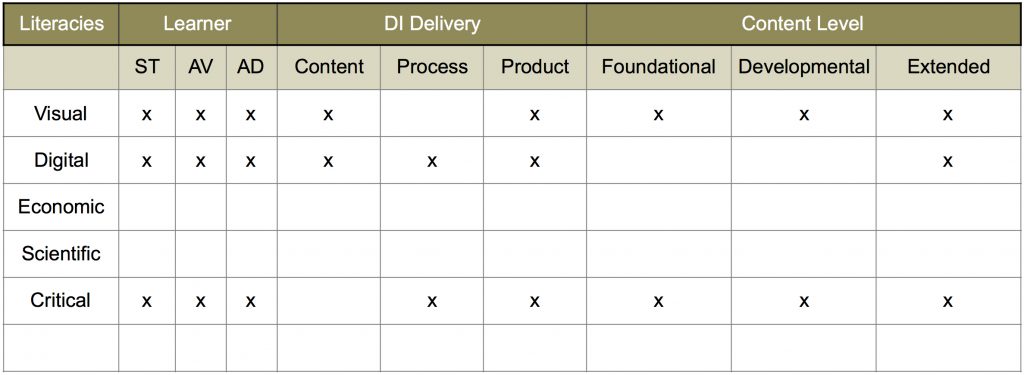This exhibit is designed to introduce my students to digital, visual and critical literacies in an engaging, multimodal way. As digital natives, they must develop the “skills and strategies with multiple virtual spaces, and … audiences” (Swaggerty, Atkinson & Cannon, 2015, p. 14) to become competent members of the increasingly global 21st century.
Beginning with this first Kindergarten unit on setting essential teamwork agreements, and then working as a team, students are exposed to digital literacy by learning to navigate an exhibit on an iPad, with their 5th Grade Buddy. Rather than just interacting with a game, students are given the opportunity for “critical engagement” (O’Rourke, 2005, p. 3) as content is delivered via a digital medium (movie). Using visual and critical literacy skills students are required to “critically analyze the author’s message” (Lapp, Moss, Rowsell, 2012, p.368) by responding to differentiated questions. Answers are recorded digitally, allowing students to “transform and redesign text information” (Lapp, Moss, Rowsell, 2012, p.368). In this way, I have given students the occasion to “learn about a new literacy while they also learn to use a new technology to share their learning” (Rosen & Terpstra, 2012, p 41).
Working then in Kinder teams of 3 or 4 students they are directed to engage in “the complex act of making meaning from … images” (visual and critical literacy) as they examine a photo of a ‘time machine’ through the thinking strategy of ‘See, Think, Wonder’. After this, students are asked to become producers, not just consumers, of text (Sanderson, 2015, p. 17), by touching one of the three boxes below to access layered activities. These activities are classified according to Nunley’s (2003) layered curriculum. Foundational activities are the “simple, basic concepts” (p. 35), Developing activities engage more “complex thinking skills” (p. 35), and Extended activities encourage the “most complex, higher-level thinking skills” (p. 35). Students will be expected to select one activity from each box. These activities are differentiated not just by taxonomic skill, but also by multiple intelligences, providing a “menu of assignment choices that represent different learning styles, abilities and … accommodations” (Nunley, 2003, p. 35).

References
De Winter, A. (2015). Time travel, ‘toons and a raspberry napoleon recipe. [Blog post image] Retrieved from http://boyeatsworld.com.au/2015/12/07/time-travel-and-a- raspberry- napoleon-recipe/
Lapp, D., Moss, B., & Rowsell, J. (2012). Envisioning new literacies through a lens of teaching and learning. The Reading Teacher, 65(6), 367-377.
O’Rourke, M. (2005). Multiliteracies for 21st century schools. ANSN Snapshot. 2(May). 1-12.
Nunley, K. F. (2003). Layered curriculum brings teachers to tiers. Education Digest, 69(1), 31- 36.
Sanderson, T. T. (2015). A journey of enacting new literacies in an early childhood education classroom. Practical Literacy: The Early & Primary Years, 20(3), 17-20.
Swaggerty, E., Atkinson, T., & Cannon, T. (2015). Making a true shift into 21st century literacy learning with multimodal digital response projects. Literacy Practice & Research, 41(1), 14-18.
Rosaen, C. C., & Terpstra, M. (2012). Widening Worlds: Understanding and teaching new literacies. Studying Teacher Education: Journal Of Self-Study Of Teacher Education Practices, 8(1), 35-49. doi:10.1080/17425964.2012.657015
Romchello, (n.d.). Dinosaurs flat icon. Retrieved from https://www.dreamstime.com/stock- illustration-dinosaurs-flat-icons-set-icon-colored-background-image44661134
Unknown, (n.d.). Cretaceous Period. [image]. Retrieved from http://www.kids- dinosaurs.com/cretaceous-dinosaurs.html
Unknown, (n.d.). Kids working together as a team. [image]. Retrieved from http://wesharepics.info/imagekgkl-kids-working-together-as-a-team.asp
Van den Brink, G.M. (Producer). (2013). Good teamwork and bad teamwork. [Video File]. retrieved from https://www.youtube.com/watch?v=fUXdrl9ch_Q